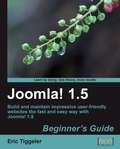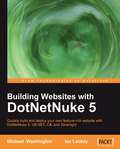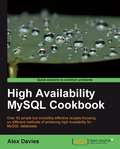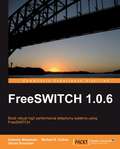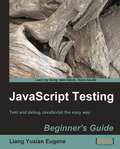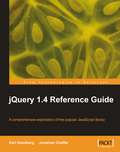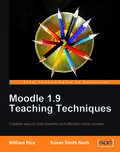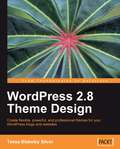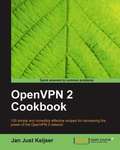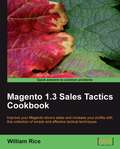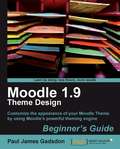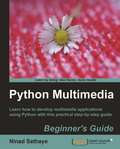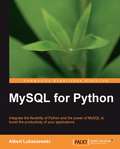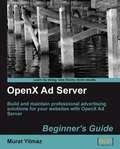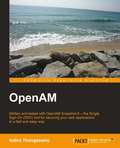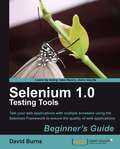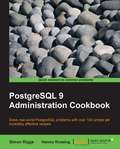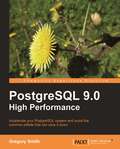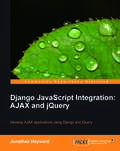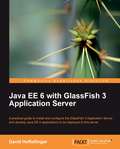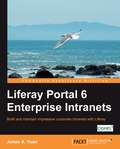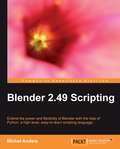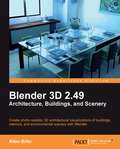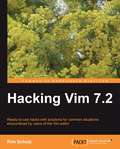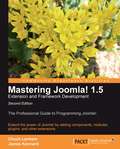- Table View
- List View
Joomla! 1.5: Beginner's Guide
by Eric TiggelerWritten with a fast-paced but friendly and engaging approach, this Packt Beginner's guide is designed to be placed alongside the computer as your guide and mentor to meet real-world web building challenges. Step-by-step tutorials are bolstered by explanations of the reasoning behind what you are doing. You will quickly pick up the necessary skills, tips, and tricks for building a successful Joomla! web site with practical examples that help you to learn by experiment and play. If you want to build and maintain your own web site, the Joomla! Beginner's Guide is perfect for you. It helps you build on the skills and knowledge you may already have on creating web sites--but even if you're new to this subject, you won't have any difficulty understanding the clear and friendly instructions and explanations. You learn how to build and maintain web sites without having to dive deep into HTML and CSS.
Building Websites with DotNetNuke 5
by Michael Washington Ian LackeyThis book is a practical tutorial with step-by-step instructions and clear, concise explanations. Illustrative screenshots are used for better understanding at every step. You will learn how to set up and administer an example site, stepping through all the tasks to ease your learning. The emphasis is not on becoming a better VB.NET or C# programmer but on taming DotNetNuke. This book has been written both for beginners wanting to set up a website and also for ASP.NET developers with a grasp of VB.NET and C# who want a deeper understanding of how to work with DotNetNuke. To work with the DotNetNuke code, you will need access to Visual Web Developer Express or Visual Studio .NET 2010. No prior knowledge of DotNetNuke is assumed.
High Availability MySQL Cookbook
by Alex DaviesThis book uses the approach of a cookbook. Each recipe provides the reader with easy step-by-step descriptions of the actions necessary to accomplish a specific task. It is designed to present what often appear as extremely complicated techniques as a series of simple-to-follow recipes, allowing readers to achieve high uptimes on their MySQL servers. This book is targeted at system administrators or database administrators who have basic familiarity with Linux, the shell, and MySQL. The typical user will be able to get MySQL installed and working, but needs practical guidance to make it highly available.
FreeSWITCH 1.0.6
by Darren Schreiber Anthony MinessaleThis book is a step-by-step tutorial with clear instructions and screenshots to guide you through the creation of a complete, cost-effective telephony system. You will start with installation, walk through the different features, and see how to manage and maintain the system. If you are an IT professional or enthusiast who is interested in quickly getting a powerful telephony system up and running using the free and open source application FreeSWITCH, this book is for you. Telephony experience will be helpful, but is not required.
JavaScript Testing Beginner's Guide
by Liang Yuxian EugeneThis book is organized such that only the most essential information is provided to you in each chapter so as to maximize your learning. Examples and tutorials are given in an easy to follow, step-by-step manner so that you can see how the testing process is being carried out and how the code is being written. The source code also contains detailed explanation so that you know what the code is doing. Multiple screenshots are used in places that matter so that you have a visual sense of what is happening. Beginner JavaScript developers looking for essential ways to write, test, and debug JavaScript for different purposes and situations.
jQuery 1.4 Reference Guide
by Karl Swedberg Jonathan ChafferThe book is a detailed reference guide, and an invaluable resource for answers to all your queries about jQuery. It is intended to be a quick reference to help at times when you need to quickly confirm a feature of the library This book is for you if you are a web developer who wants a broad, organized view of all that jQuery library has to offer or a quick reference on their desk to refer to for particular details. Basic knowledge of HTML and CSS is required. You should be comfortable with the syntax of JavaScript, but no knowledge of jQuery is assumed. This is a reference guide, not an introductory title and if you are looking to get started with jQuery (or JavaScript libraries in general) then you are looking for the companion title Learning jQuery 1.3.
Moodle 1.9 Teaching Techniques
by Susan Smith Nash William RiceThis book contains clear guidance for all who want to put together effective online courses that motivate students and encourage dynamic learning. There are clear, step-by-step instructions with helpful screenshots and diagrams to guide you along the way. If you want to unleash your teaching talents and develop exciting, dynamic courses that really get students moving forward, then this book is for you. Experienced Moodlers who want to upgrade to Moodle 1.9 will find powerful insights into developing more successful and educational courses.
WordPress 2.8 Theme Design
by Tessa Blakeley SilverTheme design can be approached from two angles. The first is simplicity; sometimes it suits the client and/or the site to go as bare-bones as possible. In that case, it's quick and easy to take a very basic, pre-made theme and modify it. The second is "Unique and Beautiful". Occasionally, the site's theme needs to be created from scratch so that everything displayed caters to the specific kind of content the site offers. This book is going to take you through the Unique and Beautiful route with the idea that once you know how to create a theme from scratch, you'll be more apt at understanding what to look for in other WordPress themes. This book can be used by WordPress users or visual designers (with no server-side scripting or programming experience) who are used to working with the common industry-standard tools like PhotoShop and Dreamweaver or other popular graphic, HTML, and text editors. Regardless of your web development skill-set or level, you'll find clear, step-by-step instructions, but familiarity with a broad range of web development skills and WordPress know-how will allow you to gain maximum benefit from this book.
OpenVPN 2 Cookbook
by Jan Just KeijserThis is a cookbook, with practical recipes providing tips and tricks to the most common problems and scenarios faced with OpenVPN.This book is ideal for system administrators and networking professionals who are interested in building secure VPNs using OpenVPN. It is preferable that the reader has a basic knowledge of OpenVPN, as well as general network administration skills.
Magento 1.3 Sales Tactics Cookbook
by William RiceThis book is written with the business owner in mind. Each of the recipes in the book supports a business objective, and is designed to increase the success of your Magento storefront. Magento beginners will find the recipes easy to follow. They are written in plain language. When special jargon is needed, it is clearly explained. The techniques are illustrated with many screenshots, showing you exactly what you must do. An example storefront is used throughout the book, so you can see exactly what effect each technique will have on your storefront. Most of these techniques stand alone, so you can jump into the book at any time and implement the techniques that are best for your storefront at this time. If you are a Magento store owner or store designer who wants to boost sales, then this book is for you
Moodle 1.9 Theme Design: Beginner's Guide
by Paul James GadsdonThis is a Beginner's Guide, with plenty of worked examples, step-by-step visual guides, and explanations. If you are a Moodle administrator, ICT technical personnel, designer or a teacher and wish to enhance your Moodle site to make it visually attractive, then this book is for you. You should be familiar with the basics of Moodle operation, and some familiarity with web design techniques, such as HTML and CSS, will be helpful.
Python Multimedia
by Ninad SathayeA practical guide, this book provides step-by-step instructions for developing multimedia applications, showcasing real world examples throughout. This book is for Python developers who want to dip their toes into working with images, animations, audio and video processing using Python.
MySQL for Python
by Albert LukaszewskiThis is a practical, tutorial-style book that includes many examples to demonstrate the full potential of MySQL for Python. Every chapter starts with an explanation of the various areas for using MySQL for Python and ends with work on a sample application using the programming calls just learned. All complicated concepts are broken down to be very easy to understand. Everything in the book is designed to help you learn and use MySQL for Python to address your programming needs in the fastest way possible. This book is meant for intermediate users of Python who want hassle-free access to their MySQL database through Python. If you are a Python programmer who wants database-support in your Python applications, then this book is for you. This book is a must-read for every focused user of the MySQL for Python library who wants real-world applications using this powerful combination of Python and MySQL.
OpenX Ad Server: Beginner's Guide
by Murat YilmazWritten with a step-by-step but friendly and engaging approach, this Packt Beginner's Guide is designed to be placed alongside the computer as your guide and mentor. Step-by-step tutorials are boosted by explanations of the reasoning behind what you are doing. You will quickly pick up the necessary skills, tips, and tricks for building a successful OpenX ad server with practical examples that help you to learn by experiment and play. If you are an enthusiast with clear IT basics, who wants to use OpenX ad server for advertising, then this book is for you.
OpenAM
by Indira ThangasamyThis book is a step-by-step tutorial stuffed with practical, real-world examples. It is designed in such a way that if you are already familiar with OpenAM, you can easily skip to a later chapter without missing a beat. You should be able to quickly grasp the basic elements of OpenAM before moving on to the more advanced features and functionality. If you are a security architect or a solution developer responsible for the design and development of web-based enterprise applications that need to provide authentication, authorization, and audit facilities along with SSO capabilities, then this book is for you. You do not require any prior knowledge of OpenAM to read this book. Familiarity with Java will be helpful, but is not essential.
Selenium 1.0 Testing Tools: Beginner’s Guide
by David BurnsWritten with a fast-paced but friendly and engaging approach, this Packt Beginner's Guide is designed to be placed alongside the computer as your guide and mentor. Step-by-step tutorials are bolstered by explanations of the reasoning behind what you are doing. You will quickly pick up the necessary skills, tips, and tricks for creating successful tests for your web applications with practical examples that help you to learn by experiment and play.If you are a Software quality assurance professional, software project manager, or software developer interested in developing automated testing in web based applications, then this book is definitely for you.
PostgreSQL 9 Admin Cookbook
by Simon Riggs Hannu KrosingWritten in the cookbook style, this book offers learning and techniques through recipes. It contains step-by-step instructions for administrators and developers to manage databases on PostgreSQL. The book is designed in such a way that you can read it chapter by chapter or refer to recipes in no particular order.This book is for Sysadmins, Database Administrators, Architects, Developers, and anyone with an interest in planning for or running live production databases. This book is most suited to those who have some technical experience.
PostgreSQL 9.0 High Performance
by Gregory SmithImproving database performance requires an equal mix of understanding theoretical concepts and working through hands-on examples. You'll find both here. Many of the examples given will be immediately useful for monitoring and improving your PostgreSQL deployments, providing insight into hard-to-obtain information about your database. This book is aimed at intermediate to advanced database administrators using or planning to use PostgreSQL. Portions will also interest systems administrators looking to build or monitor a PostgreSQL installation, as well as developers interested in advanced database internals that impact application design.
Django JavaScript Integration: AJAX and jQuery
by Jonathan HaywardThis book will teach you how to enrich your AJAX applications with Django and jQuery in a practical manner with minimum fuss. It introduces AJAX basics, gets a little deeper, and then goes chapter-by-chapter through a carefully chosen case study. It demonstrates how different pieces of a Django AJAX application work in themselves and are put together and specifically leads you through building an intranet employee photo directory with social networking features. This book is for people looking to integrate AJAX / JavaScript functionality into their web applications. It is for Django users who are looking to easily integrate AJAX features into their applications. Conversely, it will also be a priceless companion for users familiar with Django and jQuery who are and looking to integrate them in their AJAX applications. A working knowledge of Django and basic familiarity with AJAX and jQuery are assumed.
Java EE 6 with GlassFish 3 Application Server
by David R. HeffelfingerThis book is a practical guide with a very user-friendly approach. It aims to speed up the reader in Java EE 6 development. All major Java EE 6 APIs and the details of the GlassFish 3 server are covered followed by examples of its use. If you are a Java developer and wish to become proficient with Java EE 6, then this book is for you. You are expected to have some experience with Java and to have developed and deployed applications in the past, but need no previous knowledge of Java EE or J2EE. You will also learn how to use GlassFish 3 to develop and deploy applications.
Liferay Portal Enterprise Intranets
by Jonas X. YuanThis book is a practical guide with a very user-friendly approach. The author has taken a virtual enterprise as an example and has used the features of Liferay to build a corporate intranet for that enterprise. This book is for System Administrators or experienced users (not necessarily programmers) who want to install and use Liferay in their teams or businesses without dealing with complex code. Pre-knowledge of Liferay is not expected for this book.
Blender 2.49 Scripting
by Michel J. AndersThe focus of the book is on practical problems and how to solve them in Python. The examples given are useful programs that try to solve real-world needs. Each chapter revolves around a single concept giving several examples gradually growing in difficulty. Each section analyses the problem first before diving into coding and gives extensive background information to enable the reader to generalize from the specific problem to a wider range of challenges. The sample code is provided as fully working examples with all key issues extensively highlighted. All sample programs are clear and concise yet nothing essential is left out and the programming style focuses on readability rather than on stylistic rigor or efficiency. This book is for users comfortable with Blender as a modeling and rendering tool who want to expand their skills to include Blender scripting to automate laborious tasks and achieve results otherwise impossible. Blender experience is essential as is some experience in Python programming.
Blender 3D 2.49 Architecture, Buidlings, and Scenery
by Allan BritoThe book consists of a lot of exciting examples, which are shaped using the various features of Blender. It provides step-by-step instructions leading you to realistic models of buildings, landscapes, and more. A collection of amazing screenshots will add excitement to your learning experience. You can build realistic 3D models that can be used while creating different animation projects.The printed version of the book is in black and white, but a full color version of the images is available for download here. The eBook version, available from Packt, is in full color. This book is for architects, game designers, artists, or movie makers who want to create realistic buildings, interiors, and scenery using Blender 3D, a free, open-source graphics tool. This book is not a general introduction to Blender, but focuses on developing expertise on the architectural aspects of the tool. You need not have prior knowledge of Blender.
Hacking Vim 7.2
by Kim SchulzThis book is a tutorial packed with ready-to-use hacks that give solutions for common problems faced by Vim users in their everyday life. Every chapter covers a set of recipes, each of which follows a systematic approach with a self-contained description of the task it covers, how to use it, and what you gain by using it. The minimum version of Vim required for each hack is clearly indicated. If you are a Vim user who wants to get more out of this legendary text editor, this book is for you. It focuses on making life easier for intermediate to experienced Vim users.
Mastering Joomla! 1.5 Extension and Framework Development Second Edition
by James Kennard Chuck LanhamPacked with expert advice, working examples, and tips, this book is an essential reference guide that you will turn to again and again as you work with Joomla!. PHP developers who want to understand how Joomla! Works, with a view to advanced customization or extension development, and who want to learn how to work with the Joomla! Framework.
